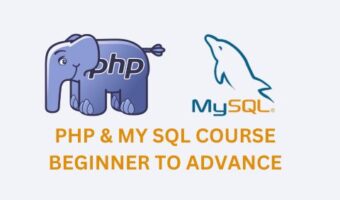PHP & My SQL Course – Beginner to Advance
About This Course
In the training of our advanced PHP course, you will be exploring the highly professional side of PHP and MySQL in our institute. PHP is a powerful and robust scripting language for server-side logic and after our PHP course training, you would be able to develop web applications, dynamic websites, data-driven projects, etc. Likewise, MySQL is a popular open-source database that is very useful in creating and handling databases for rich web development with PHP.
These are the two applications (PHP and MySQL) whose combination helps in developing database-driven web applications perfectly. Approximate 70% of the total web development industry uses this PHP and MySQL in their websites as it is open-source, easily available, has a huge community, and also has unlimited free & paid third-party resources to use.
During this PHP course, you will learn and work on various aspects of advanced PHP and MySQL along with many PHP & MySQL projects for instance CMS development, e-commerce websites development, database designing, and database optimizations. In PHP our institute will also focus on PHP’s well-known frameworks i.e. CakePHP.
In the training of our advanced PHP course you will be exploring highly professional side of PHP and MySQL in our institute. PHP is a powerful and robust scripting language for server-side logic and after our PHP course training you would be able to develop web applications, dynamic websites, data-driven projects etc. Likewise MySQL is the popular open source database which is very useful in creating and handling databases for rich web development with PHP.
These are the two applications (PHP and MySQL) whose combination helps in developing database-driven web applications perfectly. Approximate 70% of the total web development industry uses this PHP and MySQL in their websites as it is an open source, easily available, has a huge community, and also has unlimited free & paid third party resources to use.
During this PHP course you will learn and work on various aspects of advanced PHP and MySQL along with many PHP & MySQL projects for instance CMS development, e-commerce websites development, database designing, and database optimizations. In PHP our institute will also focus on PHP’s well known frameworks i.e. CakePHP.
Prerequisites to Join Advanced PHP Course
Knowledge of basic scripting languages like HTML and CSS is required and also working knowledge of at least one scripting/ programming language is desirable to learn our PHP course. Our instructors also advised you for the advanced knowledge of designing web pages using JavaScript, jQuery, and Ajax to enjoy projects after PHP-MySQL course get finished.
If you don’t match with our given eligibility criteria then you can inquire for our other web designing courses also.
Semesters and Modules:
Part I – Core PHP
- Why PHP and MySQL?
- Server-Side Scripting Overview
- Getting Started with PHP
- Learning PHP Syntax and Variables
- Learning PHP Control Structures and Functions
- Passing Information with PHP
- Learning PHP String Handling
- Learning Arrays
- Learning PHP Number Handling
- Advanced Array Functions
- Examining Regular Expressions
- Working with the Filesystem
- Working with Cookies and Sessions
- Learning PHP Types
- Performing Math with PHP
- PHP Troubleshooting
Part II – MySQL Database Integration
- Introducing Database and MySQL
- Installing MySQL
- Learning Structured Query Language(SQL)
- Learning Database Administration and Design
- Integrating PHP and MySQL
- Performing Database Queries
- Integrating Web Forms and Databases
- Improving Database Efficiency
- PDO or PHP Data Object
- MySQL Troubleshooting
Part III – Advanced PHP
- Introducing Object-Oriented PHP
- Object Oriented PHP
- Securing PHP
- Learning PHP Configuration
- Handing Exceptions with PHP
- Debugging PHP Programs
- Learning PHP Style
- Using Log Files to Improve Your Site
Part IV – Connections
- Sending E-Mail with PHP
- Integrating PHP and JavaScript
- Integrating PHP and AJAX
MySQL Database
Getting Started with MySQL and Database
- Database Basics
- What is RDBMS
- SQL Basics
- Showing Databases
- Using Databases
- What is the Role of Tables, Rows, and Fields
- Showing Tables, Columns
- Creating a Database and Table
- Column Types-String and Numeric
- Search Criteria for Retrieving Data from a Table
- Updating an Existing Data
- Altering a Table completely
- Keys And Indexes in MySQL
- Operators in MySQL
- Arithmetic Operators
- Numeric Comparison Operators
- String Comparison Operators
- Logical Operators
- Regular Expressions
Practical with MySQL Database
- Querying your data
- Sorting, Grouping and Arranging Retrieved Data
- Limiting Numbers of Results
- Joining Tables (Inner Join, Left Join, Right Join, Join etc.)
- More On Joining Tables
- Data Aggregation- sum(), avg(), max(), min(), count(), first(), last(), ucase(), lcase(), mid(), len(), round(), format() etc.
Career Options:
Module 1: Introduction to SQL Server
- The Basic Architecture of SQL Server
- RDBMS Concepts
- SQL Server Versions
- Getting Started with SQL Server Management Studio
- Basics of Databases & Tables
- In-Build Databases in SQL
- How to retrieve data from SQL
- Understanding the Order of Operations in SELECT statements
- Fetching Duplicates with DISTINCT
- Using Column and Table Aliases
- Writing Simple CASE Expressions
- Writing Order By / Group By
- Sorting Data
- Filtering Data with Predicates
- Filtering Data with TOP and OFFSET-FETCH
- Working with Unknown Values
- Using Aggregate Functions
- Using the GROUP BY Clause
- Filtering Groups with HAVING
- Introducing SQL Server Data Types
- Working with Character Data
- Working with Date and Time Data
Module 6: Adding Tables
- Creating tables
- Altering tables
- Adding new columns
- Altering existing columns
- Data type Decrease/Increase
- Simple insert
- Columns by insert
- Not Null Constraint
- Default Constraint
- Unique Key Constraint
- Primary Key Constraint
- Foreign Key Constraint
- Index Constraint
- Understanding Joins
- Querying with Inner Joins
- Querying with Outer Joins
- Querying with Left and Right Joins
- Querying with Cross Joins and Self Joins
- What are SQL Views
- How to create views
- How Views differ from Tables
- How to create Views from Joins
- LEFT, Right Functions
- UCASE, LCASE Functions
- Length, Locate, Format, Concrete, etc.
- DATE_ADD, CURRENT_DATE() , CURRENT_TIME(), Now() etc
- Dated function
- DATE_FORMAT, DAYOFWEEK,
- MONTH, YEAR, LAST_DAY
- EXTRACT, Function
- T-SQL Programming Elements
- Declaring Variables and Delimiting Batches
- Using Control-Of-Flow Elements
- Using Variables in a Dynamic SQL Statement
- Create and submit batches of T-SQL code for execution by SQL Server.
- Write code that declares and assigns variables.
- Describe the control-of-flow elements in T-SQL.
- Write T-SQL code using IF…ELSE blocks.
- Write T-SQL code that uses WHILE.
- Querying Data with Stored Procedures
- Types of Procedure in SQL
- Passing Parameters to Stored procedures
- Creating Simple Stored Procedures
- Types of Trigger I SQL
- How to use Triggers
- What are Cursors
- Eliminate Cursors with temp tables
- Transactions and the database engines
- ACID Concepts
- Controlling transactions
- Transactions – Real time Scenarios
Learning Objectives
Requirements
- This course is meant for TOTAL beginners in PHP
- No programming experience is needed at all








